Benzene detecting element and preparation process of same
a technology of detecting elements and benzene, which is applied in the field of benzene detecting elements, can solve the problems of difficult synthesis of elements, low reactivity of stable molecules, and inconvenient separation of benzene from molecules having similar nature or structure to benzene, and achieves the effect of easy synthetic methods
- Summary
- Abstract
- Description
- Claims
- Application Information
AI Technical Summary
Benefits of technology
Problems solved by technology
Method used
Image
Examples
example 1
[0052]The detecting element of the present invention was prepared as mentioned below. The preparation flow is shown in FIG. 3.
[0053]The block copolymer EO100-PO65-EO100 (EO: ethyleneoxide, PO: propyleneoxide) (F127) is dissolved in a diluted hydrochloric acid. The obtained solution is stirred at a dissolving temperature Ts=40° C., and then TEOS (tetraethylorthosilicate) as a silicate precursor is added to produce a precipitate. The solution and precipitate are aged at 80° C. for one day, and thereafter filtrated, washed with water, and air-dried at room temperature. Finally, gentle sintering is carried out. The sintering is conducted by, after heating up from room temperature to 450° C. in 8 hours, allowed to stay at 450° C. for 6 hours, cooling from 450° C. to 100° C. in 8 hours, and finally returning to room temperature by natural cooling.
[0054]According to the above process, a mesoporous silicate (SBA-16) having uniform fine pores of two kinds, i.e. a nanosized fine pore having a...
example 2
[0062]Detection of an exhaust gas from an automobile was carried out by the same manner as in EXAMPLE 1. There are cases where a humidity of the exhaust gas is 80% or higher, and as to the number of molecules contained in the gas, water is predominantly large, therefore, interference by water causes serious problems in a detecting method by using a conventional adsorbent. However, when using the present invention, regardless of humidity, a very strong signal of benzene was detected (FIGS. 6A-6B). FIG. 6A shows a graph representing a signal intensity of a conventional benzene detecting element, and FIG. 6B shows a graph representing a signal intensity of the benzene detecting element of the present invention. From the above, according to the present invention, benzene slightly present in atmospheric air can be detected selectively at a high sensitivity.
PUM
| Property | Measurement | Unit |
|---|---|---|
| pore size | aaaaa | aaaaa |
| pore size | aaaaa | aaaaa |
| pore size | aaaaa | aaaaa |
Abstract
Description
Claims
Application Information
 Login to View More
Login to View More - R&D
- Intellectual Property
- Life Sciences
- Materials
- Tech Scout
- Unparalleled Data Quality
- Higher Quality Content
- 60% Fewer Hallucinations
Browse by: Latest US Patents, China's latest patents, Technical Efficacy Thesaurus, Application Domain, Technology Topic, Popular Technical Reports.
© 2025 PatSnap. All rights reserved.Legal|Privacy policy|Modern Slavery Act Transparency Statement|Sitemap|About US| Contact US: help@patsnap.com



